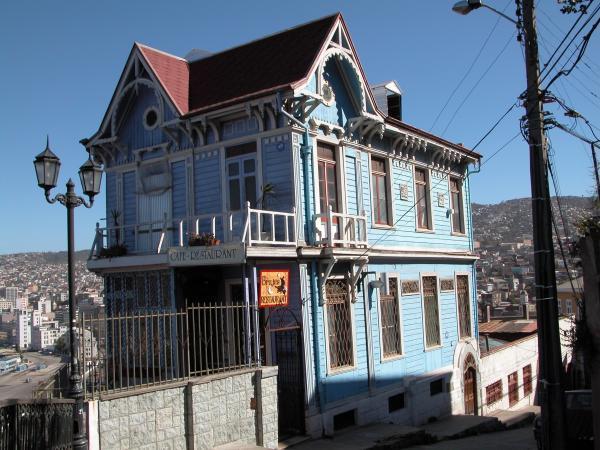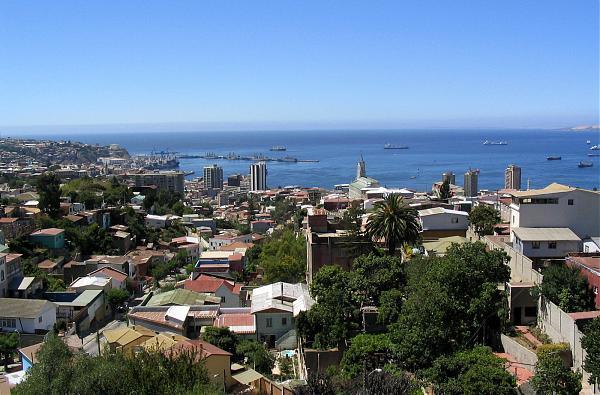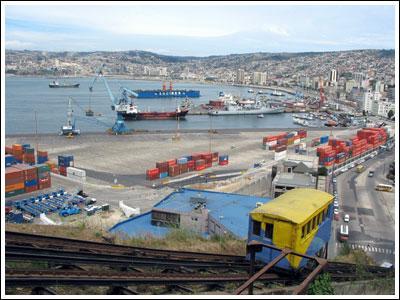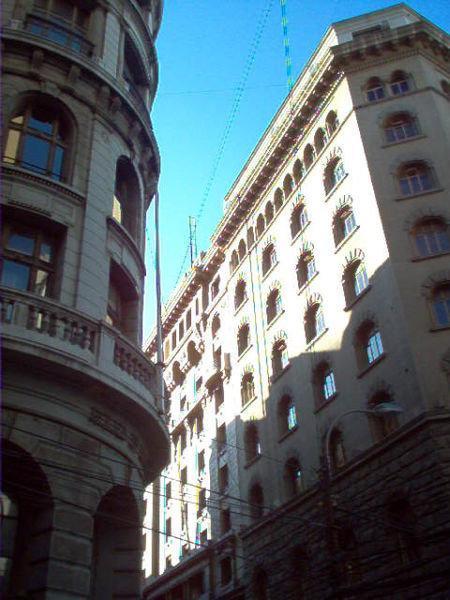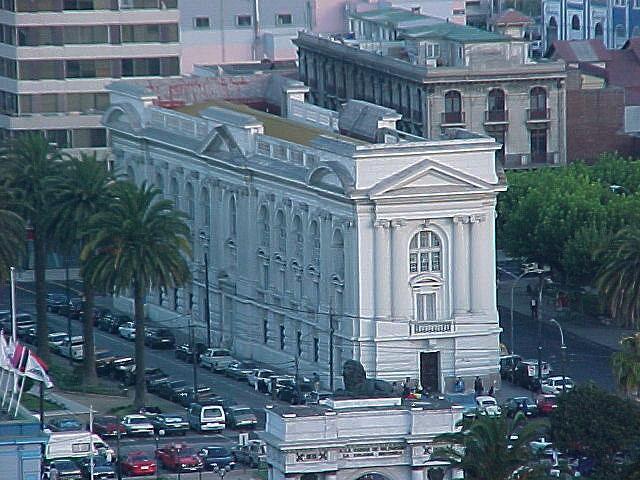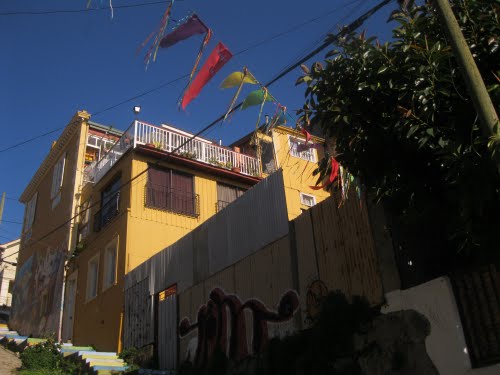Valparaiso is a major city, seaport, and educational center in the county or commune of Valparaiso, Chile. Greater Valparaiso is the second largest metropolitan area in the country. Valparaiso is located 111.8 kilometres northwest of Santiago and is one of the South Pacific's most important seaports. Valparaiso is the capital of Chile's third most populated administrative region and has been the headquarters for the Chilean National Congress since 1990.
Valparaiso played an important geopolitical role in the second half of the 19th century, when the city served as a major stopover for ships traveling between the Atlantic and Pacific oceans by crossing the Straits of Magellan. Valparaiso mushroomed during its golden age, as a magnet for European immigrants, when the city was known by international sailors as "Little San Francisco" and "The Jewel of the Pacific". In 2003, the historic quarter of Valparaiso was declared a United Nations Educational, Scientific, and Cultural Organization (UNESCO) World Heritage Site.
Examples of Valparaiso's renown glory include Latin America's oldest stock exchange, the continent's first volunteer fire department, Chile's first public library, and the oldest Spanish language newspaper in continuous publication in the world, El Mercurio de Valparaiso.
The second half of the twentieth century was not kind to Valparaiso, as many wealthy families abandoned the city. The opening of the Panama Canal and reduction in ship traffic dealt a staggering blow to Valparaio’s port-based economy. However, over the past 15 years, the city has staged an impressive renaissance, attracting many artists and cultural entrepreneurs who have set up shop in the city's hillside historic districts. Today, many thousands of tourists visit Valparaiso from around the world to marvel at the city's unique labyrinth of cobbled alleys and colorful buildings. The port of Valparaiso continues to be a major distribution center for container traffic, copper, and fruit exports. Valparaiso also receives growing attention from cruise ships that visit during the South American summer. Most significantly, Valparaiso has transformed itself into a major educational center with four large traditional universities and several large vocational colleges. The city exemplifies Chilean culture, with festivals every year, and a number of street artists and musicians.
History
Valparaiso's bay was probably first populated by the Picunche natives, known for their agriculture, or the Chango people, who were nomads dedicated to fishing, and traveling between modern-day Caldera and Concepcion. Spanish explorers, considered the first European discoverers of Chile, arrived in 1536 aboard the Santiaguillo, a supply ship sent by Diego de Almagro. The Santiaguillo carried men and supplies for Almagro's expedition, under the command of Juan de Saavedra, who named the town after his native village of Valparaiso de Arriba in Cuenca, Spain.
During Spanish colonial times, Valparaiso remained a small village, with only a few houses and a church.
In 1810 a wealthy merchant built the first pier in the history of Chile and the first during the colonial era. In its place today, stands the building of El Mercurio de Valparaiso. The ocean then rose to this point. Reclamation of land from the sea moved the coastline five blocks away. Between 1810 and 1830 he built much of the existing port of the city, including much of the land reclamation work that now provides the city's commercial centre.
Valparaiso soon became a desired stopover for ships rounding South America via the Straits of Magellan and Cape Horn. It gained particular importance supporting and supplying the California Gold Rush (1848–1858). As a major seaport, Valparaiso received immigrants from many European countries, mainly from Britain, Germany, France, Switzerland and Italy. German, French, Italian and English were commonly spoken among its citizens, who founded and published newspapers in these languages.
International immigration transformed the local culture from Spanish origins and Amerindian origins, in ways that included the construction of the first non-Catholic cemetery of Chile, The Cemetery of Dissidents. Football was introduced to Chile by English immigrants and the first private Catholic school in Chile, French immigrants in Valparaiso, which has been operating for about 170 years. Immigrants from Scotland and Germany founded the first private secular schools. Immigrants formed the first volunteer fire-fighting units. Their buildings reflected a variety of European styles, making Valparaíso more varied than some other Chilean cities.
In August 18, 1906 a major earthquake struck Valparaiso, there was extensive property damage and thousands of deaths. The Chilean doctor Carlos Van Buren, of U.S. descent, was involved in medical care of earthquake victims. He later established a modern hospital Carlos Van Buren Hospital in 1912.
The golden age of Valparaiso's commerce ended after the opening of the Panama Canal (1914). Shipping shifted to the canal as captains sought to avoid the risks of the Strait of Magellan. The port's use and traffic declined significantly, causing a decline in the city's economy. Since the turn of the 21st century, shipping has increased in the last few decades with fruit exports, increasing opening of the Chilean economy to world commerce, and larger-scale, Post-Panamax ships that do not fit the Panama Canal.
19th century
On March 28, 1814, the USS Essex is defeated by British frigates Phoebe and Cherub during the War of 1812, leading to the deaths of 58 US Marines. By August 2, 1820, the Liberating Expedition of Peru sails from Valparaiso.
The evening of November 19, 1822 Valparaiso experienced occurs a violent earthquake that leaves the city in ruins, of the 16,000 residents, casualties included at least 66 adults and 12 children, as well as 110 people wounded. The next day a meteor trail was visible from Quillota to Valparaíso, seen as a religious experience for much of the population.
In 1826, the Royal Navy Great Britain establishes a South America Station in Valparaiso to maintain British naval interest in the region. It would remain until 1837 when it was relocated to Esquimalt, British Columbia.
September 12, 1827 saw the establishment of El Mercurio de Valparaiso, currently the oldest circulating newspaper in the Spanish language worldwide.
In May 1828, a constitutional convention begins regular meeting in the church of San Francisco. By August 9, the Constitution of the Republic of Chile would be fully drafted and disseminated.
On June 6, 1837, Minister Diego Portales is shot at the port outside of Baron Hill on suspicion of promoting conspirators who opposed the Peru-Bolivian Confederation, considered a turning point of Chilean public opinion and the purpose of the war.
By 1851, the first fire brigade in the country is formed. The next year potable running water becomes available, as well as the first telegraph service in Latin America, between the city and Santiago. It would be another four years before streetlights, with 700 gas lanterns, are installed. In 1861 the first tram company is formed, mostly using horse or mules to draw them, and fully established over the next few years.
Taking advantage of the total lack of defenses a Spanish fleet commanded by Casto Mendez Nunez bombarded the city during the Spanish-South American war in 1866. Chilean merchant ships are sunk, except for those vessels whose captains hoisted foreign flags.
A merger of the National Steamship Company and Chilean Steamship Company, the South American Steamship Company was created as a national response to the increasing dominance of the Pacific Steam Navigation Company in 1872. In 1880 the Chilean Telephone Company is formed by Americans Joseph Husbands, Peter MacKellar, James Martin, and the US consul Lucius Foot, the first official telephone company in the country. Three years later on the first of December, Concepcion funicular opens, the first of many hydraulic systems.
After the country's independence and its consequent openness to international trade, Valparaiso becomes an important port of call on trade routes through the Eastern Pacific. Many immigrants settled there, mostly from Europe and North America, who helped include Valparaiso and Chile in the industrial revolution sweeping other parts of the world. This created a different city with civil, financial, commercial and industrial institutions, many of which still exist today.
All this resulted in a population increases. The city reached more than 160,000 inhabitants in the late nineteenth century, making it necessary to use the steep hills for more houses, mansions and even cemeteries. The lack of available land caused the city authorities and developers to reclaim low lying tidal marshland to build administrative, commercial and industrial infrastructure.
20th century
The twentieth century began with the first big protest of dockworkers, Chile on April 15, 1903, due to complaints by Dockers about their excessive working hours and demands for higher wages, requests that were ignored by employers, creating a tense situation that led to serious violence on May 12. There were protests and the burning of the CSAV offices and several people were shot and killed. All this prompted intervention by the state. This protest was important for the future of Trade Unionism in the country.
The same year, electric trams appeared.
The 1906 Valparaiso earthquake caused severe damage throughout the city on August 16, which was at that time the heart of the Chilean economy.
Damage was valued at hundreds of millions of pesos of the time, and human victims were counted at 3,000 dead and over 20,000 injured. After removing the debris, reconstruction work began. These included the widening of streets, culverting and covering streams. The main street of the city was laid and Plaza O'Higgins was created a hill was removed to allow the passage of Colon Street. The damaged Edwards mansion was demolished and in its place the present Cathedral of Valparaiso was built and, among many other works, this gave shape to the current Almendral Valparaiso area.
In 1910 the port expansion work of the city, which ended in 1930, began. A long breakwater was built, along with piers and docking terminals.
The opening of the Panama Canal in 1914 caused a severe reduction of port activity as Valparaiso lost its vital role as the major stopping point for shipping going from the North Atlantic to the North Pacific via the Magellan channel.
21st century
Currently Chile's legislature along with other institutions of national importance like the National Customs Service, the National Fish and Aquaculture Ministry, the Ministry of Culture and the Barracks General of the Chilean Navy are sited in the city. In addition to the capital of the Valparaiso Region hosts the Regional Administration and government.
In February 2013, about 105 homes were destroyed in Valparaiso, affecting 1,200 people. On April 13, 2014 a huge brush fire burned out of control, destroying 2,800 homes and killing 16 people, forcing President Michelle Bachelet to declare it a disaster zone.

